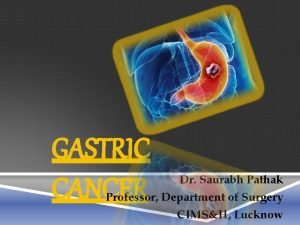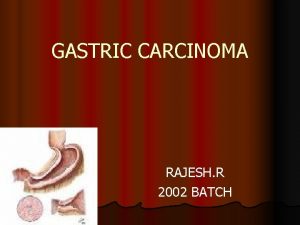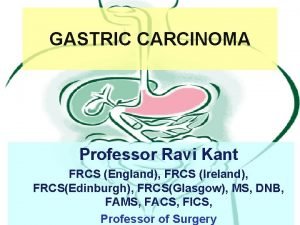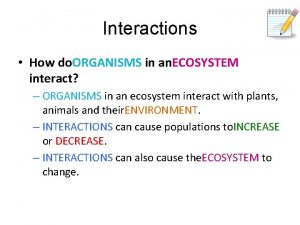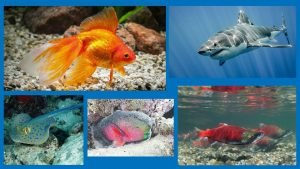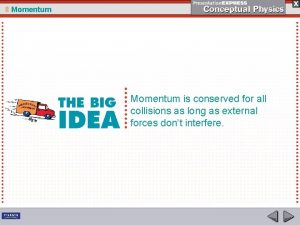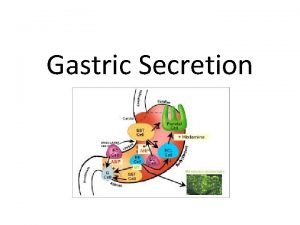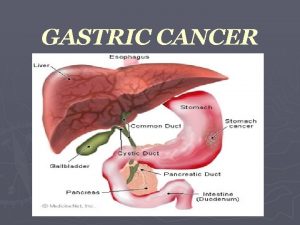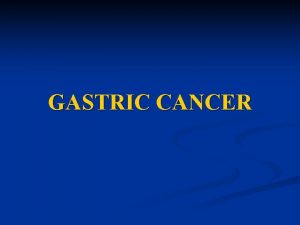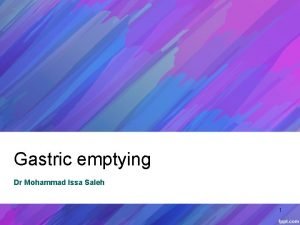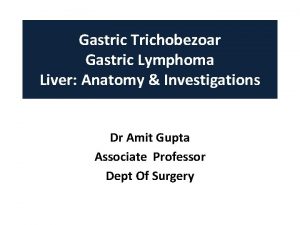Gastric Cancer related to Fish Intake Among the














- Slides: 14

Gastric Cancer related to Fish Intake Among the Asian Community Cassie Steck February 23, 2007

Statistics • • 2 nd leading cause of cancer worldwide. Accounts for more than 1 million deaths per year. High incidence in Korea, Japan, China. Asia accounts for 56. 4% of world population. 59. 9 Japanese men per 100, 000 population developed gastric cancer in 2000. 23. 8 Japanese women per 100, 000 population developed gastric cancer in 2000. 31. 2 Japanese men per 100, 000 population died from gastric cancer in 2000. 13. 8 Japanese women per 100, 000 population died from gastric cancer in 2000.

Developing Gastric Cancer Heliobactor pylori • Untreated infections can lead to gastric cancer. • Overcrowding allowing H. pylori to be spread • • • person to person. 60% of the younger Asian population is infected with H. pylori. 90% of the elder Asian population is infected with H. pylori. Only 30% of Western populations is infected with only 0. 1 -1% developing gastric cancer.

Developing Gastric Cancer Smoking • Smokers are more prone to stomach ulcers. • 10. 2% of Chinese people smoke. • 17. 7% of Japanese people smoke. • 21% of Koreans smoke. • 20. 9% of Americans smoke.

Developing Gastric Cancer Diet • Pickled, dried, smoked, and salted foods such as • fish contain nitrates that are converted into carcinogenic compounds in the stomach increasing the likelihood for gastric cancer. Estimated 90% of gastric cancer is due to dietary factors.

H. pylori • Induces physiological changes in gastric mucosa. • Transmitted by fecal oral route. • Neutralophile growing best at a p. H 6. 0 -8. 0. – Contains urease, which enables the organism to maintain an internal neutral p. H while in a highly acidic enviroment. – Invades stomach where p. H is highest – the antrum. – Antacids, H 2 blockers, and PPIs can worsen the situation.

H. pylori • Colonization leads to hypochlorhydria and • • gastric atrophy. Nitrogen-fixing bacteria are able to colonize permitting carcinogenic behavior. Two virulence factors CAG – & CAG +; CAG – less intense, very rare in Asians; CAG + more intense.

Smoking • Nicotine is extremely harmful to gastric mucosa. • Nicotine induces: – Tumor cell proliferation via COX-2 pathway – Angiogenesis • Caused by release of vascular endothelial growth factor (VEGF) allowing for nutrients, blood, and oxygen to support the tumor. • VEGF increases metalloproteinases promoting gastric cancer spread. – Salivation • Increases gastric acid secretion, decreasing the p. H. – Inflammatory process • Decreases histone deacetylase, increasing inflammatory response.

Diet: Fish and Nitrates • Most Asians consume diets high in salt and nitrates and low • in fruits and vegetables. – Salted or smoked fish, pickled vegetables, miso soup, soybeans. – These foods are consumed 5 days a week by 20. 6% of Japanese males and 17. 3% of females. Intake of nitrosamines – Formed during food preservation, cooking, and from smoking. – Data shows that nitrosamines are found more frequently in Asian food than in Western food.

Diet: Salt • Salt – Initiates inflammatory process leading to damage of gastric mucosa. – Induce gastritis and cell proliferation. • Amount of salt consumed – Japanese men 4082 mg day; Japanese females 3, 970 mg day – American men and women 3, 375 mg day.

Fish Is Not All Bad!! • Fish intake benefits reproduction and the • • cardiovascular system. Fish oil contains EPA and DHA, essential components of nervous cell membranes. Pre-natal DHA intake reduced premature labor. Post-natal DHA intake was correlated with visual and language development. Reduction in lipid levels and platelet aggregation provide cardiovascular benefits.

Presentation • Usually non-specific symptoms – Commonly diagnosed in later stages. • Common complaints are: loss of appetite, fullness, • • • N/V, hematemesis, abdominal pain, excessive belching, and unintentional weight loss. Secondary Sx may be due to metastatic disease. Hx of previous ulcers or PUD. Gold-standard diagnostic procedure is upper GI endoscopy.

Conclusion • Overall survival rate in US is 24%. • Overall survival rate in Asia is 53% if caught in an early stage. – Asia does mass screenings with upper GI endoscopy at age 50. • Many different causes of gastric cancer but diet and salt • • intake are the main difference between Asians and Americans. Today there is no positive link between diet and gastric cancer, but with a reduction in fish intake the risk of gastric cancer in Asians would greatly decrease. Preventative measures – Different cooking methods without changing Asian’s culture.

References • • • • • • • American Cancer Society, What are the key statistics about stomach cancer? 2006, Available at: http: //www. cancer. org/docroot/CRI/content/CRI_2_4_1 X_ What_are_ the_key_statistics_for_stomach_cancer_40. asp? sitearea=. Accessed Jan. 27, 2007. American Lung Assocation, Smoking 101 Fact Sheet. March 2006. Available at: http: //www. lungusa. org/site/pp. asp? c =dv. LUK 9 O 0 E&b=39853. . Accessed Feb. 14, 2007. http: //www. lungusa. org/site/pp. asp? c=dv. LUK 9 O 0 E&b=39853 Cai L, Yu S, Ye W, Yi Y. Fish Sauce and gastric cancer: an ecological study in Fujian. Province, China. World J Gastroenterology. 2000 Oct; 6 (5): 671 -675. Campaign for Tobacco-Free kids, Benefits from tobacco cessation. 2003, Available at: http: //www. worthit. org/pfds/benefitsquit. pdf. . Accessed Dec 2 2006. Dale D, Federman D, Antman K, Atkinson J, Cassel C, Feldman M et al. ACP Medicine. 2006 ed. Webmd. 2006. e. Medicine, /MED/topic 845. htm. e. Medicine, Gastric cancer. June 2004. Available at: http: //www. emedicine. com/MED/topic 845. htm. Accessed Dec 2 2006. Gochfeld M, Burger J. Good fish/bad fish: A composite benefit – risk by dose cure. J Neurotoxicology. 2005 August; 26 (4); 511 -520. In this issue. J National Cancer Institute. 2001; 93 (14); 1039. Internet World Stats, Internet Usage in Asia. 2001. Available at: http: //www. internetworldstats. com/stats 3. htm. Accessed Dec 1 2006. Jakszyn P, Gonzalez C. Nitrosamine and related food intake and gastric and esophageal cancer risk: A systematic review epidemiological evidence. World J Gastroenterology. 2006 July 21; 12 (27): 4296 -4303. Kim Karen. Gastric cancer in Korean Americans: risks and reductions. American Studies Bullentin. 2003; 13 (1/2): 84 -90. Medscape. New data presented on the pathogenesis of smoking-induced lung injury. 2002. Available at: http: //www. medscape. com/viewarticle/442808. Accessed Dec 2 2006. Nangta Chisato, Takatsuka Naoyoshi, Shimizu Natsuki, Shimizu Hiroyuki. Sodium intake and risk of death from stroke in Japanese men and women. American Heart Association. 2004; 35: 1543. Nanda Rita. Medical encyclopedia: Gastric cancer. 2006 Sept 11. Available at: http: //www. nlm. nih. gov/medlineplus/ency/article/000223. htm. Accessed Jan. 28, 2007. OHSU Health, Cancer Information. 2001. Available at: http: //www. ohsucancer. com/index. asp? fuseaction =cancerby. Type. lookup&list=stomach http: //www. ohsucancer. com/index. asp? fuseaction= cancerby. Type. lookup&list=stomach. . Accessed Dec 2, 2006. Prinz C, Schwendy S, Voland P. H pylori and gastric cancer: shifting the global burden. World J Gastroenterology. 2006 Sept 14; 12 (34): 5458 -5464. Rollan Antonio, Ferreccio Catterina, Gederlini Alessandra, Serrano Carolina, Torres Javiera, Harris Paul. Non-invasive diagnosis of gastric mucosal atrophy in an asymptomatic population with high prevalence of gastric cancer. World J Gastroenterology. 2006 Nov 28; 12 (44): 7172 -7178. Shin Vivian, Wu William, Chu Kent, Wong Helen, Lam Emily, Tai Emily et al. Nicotine induces cyclooxygenase-2 and vascular endothelial growth factor receptor-2 in association with tumor-associated invasion and angiogenesis in gastric cancer. Molecular Cancer Research. 2005; 3: 607 -615. Smith M, Hold G, Tahara E, El-Omar E. Cellular and molecular aspects of gastric cancer. World J Gastroenterology. 2006 May 21; 12 (19): 2979 -2990. Strumylaite L, Zickute J, Dudzevicius J, Dregval L. Salt-preserved foods and risk of gastric cancer. Medicina (Kaunas). 2006; 42 (2): 164 -170. Tsugane S. Sasazuki S, Kobayashi M, Sasaki S. Salt and salted food intake and subsequent risk of gastric cancer among middle-aged Japanese men and women. British J Cancer. 2004; 90: 128 -134. U. S. Department of Health and Human Services, Office of Applied Studies. Aug 2006. Available at: http: //www. oas. samhsa. gov/nhsda/2 k 1 nhsda/vol 1/chapter 4. htm. Accessed Dec 2, 2006. World Health Organization, Media Centre. February 2006. Available at: http: //www. who. int/mediacentre/factsheets/fs 297/en/index. html. Accessed Dec. 2, 2, 2006. Wright Jacqueline, Wang Chia, Stephenson Jocelyn, Ervin Bethene. Dietary intake of ten key nutrients for public health, United States 1999 -2000. Advanced data from vital and health statistics, 2003 April 17; 334.
 One fish two fish red fish blue fish ride
One fish two fish red fish blue fish ride One fish two fish blowfish blue fish
One fish two fish blowfish blue fish One fish two fish red fish lungfish
One fish two fish red fish lungfish How to avoid gastric cancer
How to avoid gastric cancer Borrmann classification of gastric cancer
Borrmann classification of gastric cancer Subtotal gastrectomy
Subtotal gastrectomy Two type of physical fitness
Two type of physical fitness Health vs skill related fitness
Health vs skill related fitness Among fish
Among fish What are the market forms of shellfish
What are the market forms of shellfish Anatomy of fish reproductive system
Anatomy of fish reproductive system Spiracles in fish
Spiracles in fish A big fish swims up and swallows a small fish at rest
A big fish swims up and swallows a small fish at rest Lời thề hippocrates
Lời thề hippocrates Dạng đột biến một nhiễm là
Dạng đột biến một nhiễm là



